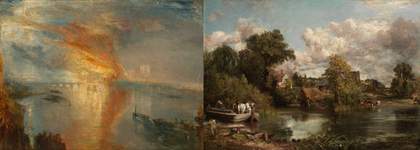
Left to Right: JMW Turner, The Burning of the Houses of Lords and Commons, 16 October 1834, 1835. Cleveland Museum of Art. Bequest of John L. Severance 1942.647; John Constable, The White Horse, 1819. © The Frick Collection, New York. Photo: Joseph Coscia Jr
This autumn, Tate Britain will present the first major exhibition to explore the intertwined lives and legacies of Britain’s most revered landscape artists: JMW Turner (1775–1851) and John Constable (1776–1837). Radically different painters and personalities, each challenged artistic conventions of the time, developing ways of picturing the world which still resonate today. Staged across the 250th anniversary years of their births, this exhibition will trace the development of their careers in parallel, revealing the ways they were celebrated, criticised and pitted against each other, and how this pushed them to new and original artistic visions. It will feature over 170 paintings and works on paper, from Turner’s momentous 1835 The Burning of the Houses of Lords and Commons, lent by Cleveland Museum of Art and not seen in Britain for over a century, to The White Horse 1819, one of Constable’s greatest artistic achievements, last exhibited in London two decades ago.
Born only a year apart - Turner in London’s crowded metropolis and Constable to a prosperous family in the Suffolk village of East Bergholt - their contrasting early lives will begin the exhibition. Turner was a commercially minded, fast-rising young star who first exhibited at the Royal Academy in 1790 aged just 15, and created ambitious oil paintings like recently-discovered The Rising Squall, Hot Wells, from St. Vincent’s Rock, Bristol, before he turned 18. By contrast, largely self-taught Constable undertook sketching tours to create early watercolours like Bow Fell, Cumberland 1807 and demonstrated a fierce commitment to perfecting artistic techniques, not exhibiting at the Royal Academy until 1802. Having both emerged amid an explosion in popularity of landscape art, the two were united however, in their desire to change it for the better.
The exhibition will explore how both artists developed distinct artistic identities within the competitive world of landscape art, spotlighting their methods, evolution and overlap. Constable built his reputation on the Suffolk landscapes of his childhood, opting to sketch in oils outside amid the vast views of Dedham Vale and the river Stour, which often recurred in his work. Tate Britain will include his painting box and sketching chair, with visitors able to chart the development of Constable’s skilful draughtsmanship and radical handling of paint to add ‘sparkle’. A group of Constable’s cloud studies will be brought together for the exhibition. Reflective of his belief that the sky was key to the emotional impact of a painting they are now one of the most celebrated aspects of his output and underpinned the powerful skyscapes in the artist’s monumental six-foot canvases. Late works such as Hampstead Heath with a Rainbow 1836 will illustrate his deft interweaving of personal and historic memories.
By contrast, Turner travelled widely across Britain and Europe filling sketchbooks with quick pencil studies. This offered creative inspiration, influencing sublime Alpine scenes such as The Passage of Mount St Gothard from the Centre of Teufels Broch (Devil’s Bridge) 1804, as well as commercial opportunities to have prints made after his watercolours. The exhibition will explore how Turner developed original ways to apply paint and depict light, capturing the raw power of nature. Some of Turner’s most celebrated late works will feature, including Ancient Italy – Ovid Banished from Rome, first exhibited in 1838 and not shown in London in over 50 years.
By the 1830s, both Turner and Constable became recognised for taking landscape painting in bold new directions. The stark differences between their work spurred art critics to pit them against one another and to cast them as rivals. In 1831 Constable himself played into this, placing his and Turner’s work side by side at the Royal Academy exhibition. This showing of Turner’s Caligula’s Palace and Bridge next to Constable’s Salisbury Cathedral from the Meadows, prompted a flurry of comparisons between the sun-drenched heat of Turner’s mythical Italian scene and Constable’s damply atmospheric Britain; they were ‘fire and water’. Now placed head-to-head at Tate Britain, the artists’ most distinctive and impressive paintings will highlight how, despite their differences, they made landscape a genre worthy of grand canvases and prime importance.
Creators of some of the most daring and captivating works in the history of British art, Turner and Constable changed the face of landscape painting with their two competing visions, elevating the genre with their recognition of its endless potential to inspire. The exhibition will end with a new film featuring contemporary artists Frank Bowling, Bridget Riley, George Shaw and Emma Stibbon reflecting on the enduring legacy of Turner and Constable.
